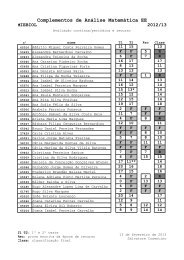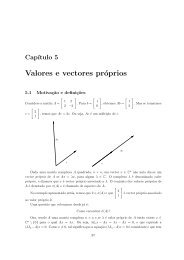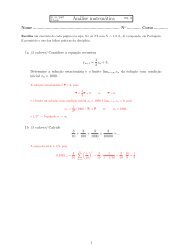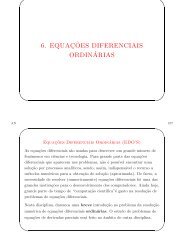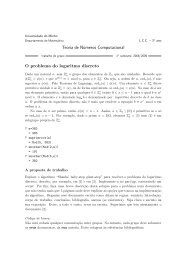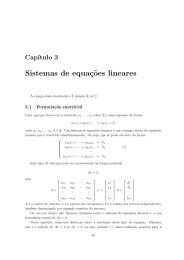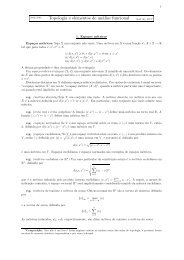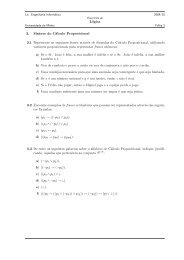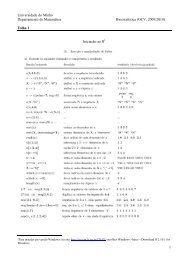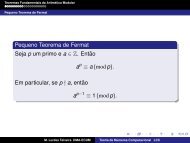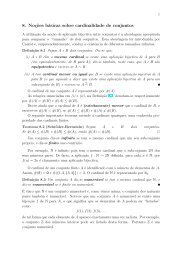My title - Departamento de Matemática da Universidade do Minho
My title - Departamento de Matemática da Universidade do Minho
My title - Departamento de Matemática da Universidade do Minho
Create successful ePaper yourself
Turn your PDF publications into a flip-book with our unique Google optimized e-Paper software.
5 ÓRBITAS REGULARES E PERTURBAÇÕES 38<br />
Proof. We may assume, without loss of generality, that the root we are looking for is the origin,<br />
so that p(0) = 0. Now, suppose we are at x n after n iterations. Taylor’s formula with Lagrange<br />
estimate of the error around x n says that<br />
p(x) = p(x n ) + p ′ (x n ) · (x − x n ) + 1 2 p′′ (y) · (x − x n ) 2<br />
for some y between x and x n . Taking x = 0 (the root!) and dividing by p ′ (x n ) we get<br />
0 = p(0) = p(x n ) − p ′ (x n ) − x n + 1 2 p′′ (y) · x 2 n i.e. x n − p(x n)<br />
p ′ (x n ) = 1 p ′′ (y)<br />
2 p ′ (x n ) · x2 n<br />
But the l.h.s. is x n+1 . There follows that the distance ε n = |x n − 0| between the n-th iterate and<br />
the root satisfies the iterative bound<br />
|x n+1 | ≤ 1 p ′′ (y)<br />
2 ∣p ′ (x n ) ∣ · |x n| 2<br />
Since p ′ (0) ≠ 0 (and polynomials have continuous <strong>de</strong>rivatives), there is an interval I =] − ε, ε[<br />
around the root 0 where M = sup x∈I |p ′′ (x)| < ∞ and δ = inf x∈I |p ′ (x)| > 0. Let K = M/2δ. If<br />
the initial guess is sufficiently near the root 0 (so near that |x 0 | < 1 and also K|x 0 | < 1), then the<br />
x n ’s converge to 0 and the convergence is quadratic, i.e.<br />
|x n+1 | ≤ K · |x n | 2<br />
Exercícios.<br />
• Verifique que o méto<strong>do</strong> <strong>de</strong> Newton aplica<strong>do</strong> ao polinómio quadrático z 2 − a, com a > 0,<br />
correspon<strong>de</strong> ao algoritmo <strong>de</strong> Heron!<br />
• Estime √ 17 ...<br />
• Escreva a receita <strong>do</strong> méto<strong>do</strong> <strong>de</strong> Newton para resolver z n − a = 0, com a > 0 e n ≥ 2.<br />
• Utilize o méto<strong>do</strong> <strong>de</strong> Newton para estimar raizes <strong>de</strong><br />
Iteração <strong>de</strong> funções racionais.<br />
z 2 + 1 + z z 3 − z − 1 z 5 + z + 1 z 3 − 2z − 5



